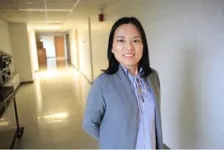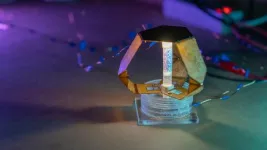(Press-News.org) BLOOMINGTON, Ind. — Similar to a burglar breaking a window to get into a house, Indiana University researchers have discovered a previously unknown process by which pathogens enter a cell with physical force, breaching the body's immune defenses that prevent infection.
The work, published in the journal Proceedings of the National Academy of Sciences, introduces a potential game-changer in the fight against intracellular pathogens responsible for causing devastating infectious diseases, such as tuberculosis, malaria and chlamydia. These diseases are notoriously difficult to treat because the pathogens are protected inside host cells.
“Using the parasite Toxoplasma as our representative pathogen, our work shows that some intracellular pathogens can apply physical forces during their entry into host cells, which then allow the pathogens to evade degradation and to survive intracellularly,” said study lead author Yan Yu, professor in the College of Arts and Sciences’ Department of Chemistry at IU Bloomington. “This work suggests that targeting the motility of pathogens may be a new way to combat infection inside cells.”
Normally, when an invading pathogen encounters a phagocyte — a type of white blood cell responsible for destroying bacteria, viruses and other types of foreign particles — it is caught and ingested by the phagocyte. For pathogens that escape this process, it is commonly thought that those pathogens must release a "secret arsenal" to “paralyze” the degradative machineries in the cell.
However, Yu’s study shows that this common belief is not true. She and collaborators have found that pathogens can avoid being ingested within the immune cell by exerting a “propulsive force.” With this forceful entry, the pathogens are diverted into vacuoles that lack the ability to break down these infiltrators. A vacuole is a structure reserved for storage and digestion within a cell.
To conduct the research, Yu and colleagues introduced the disease-causing parasite Toxoplasma into mouse-derived cells, observing their behaviors through a fluorescence microscope. These live parasites forcefully entered and thrived within immune cells.
The biggest challenge then was to determine whether the live parasite escapes the immune defense with unknown chemical substances, or simply through force. To tackle this question, Yu and her team took an inventive approach: They created inactivated parasites that cannot exert force or create chemical substances. Unlike live parasites, these “zombie” parasites were swiftly degraded in the cell.
The researchers then employed magnetic tweezers to push the inactivated parasite into the immune cell to mimic the forceful entry observed in live Toxoplasma. The inactivated parasite, now subjected to simulated forceful entry, evaded degradation, akin to its live counterpart. This suggests that the force of entry, not chemicals, explains the pathogen’s survival, Yu said.
To manipulate the movement of the parasite in the second experiment, the researchers had to develop the “tweezer system” with magnetic nanoparticles. They also collaborated with a team at the University of Tennessee to develop computational models to simulate the behavior.
In addition, the researchers conducted the same experiments using yeast to confirm that the mechanism observed could also be found in other infectious agents, not just Toxoplasma.
"This study elucidates the contribution of physical forces in immune evasion and underscores the importance of targeting pathogen movement to combat intracellular infections,” Yu said. “We’re hopeful this work may ultimately contribute to new efforts to fight a variety of infections that are harmful to human health.”
Other IU researchers on the study were first author Zihan Zhang, as well as Jin Ou, Yanqi Yu and Qiong Zhou. Additional co-authors are Thomas K. Gaetjens and Steven M. Abel at the University of Tennessee. This work was supported by the National Institutes of Health and the National Science Foundation.
END
Pathogens use force to breach immune defenses, study finds
2023-12-01
ELSE PRESS RELEASES FROM THIS DATE:
Keeping Texas bridges ‘safe and usable for years to come’
2023-12-01
Texas has the second-most bridges in the United States after California, 30% of which do not have sufficient height, width or capacity to handle the increasing volume and type of traffic using them.
Nur Yazdani, a civil engineering professor at The University of Texas at Arlington, has received a three-year, $997,275 grant from the Texas Department of Transportation (TxDOT) to evaluate the performance of selected deteriorating and aging highway bridges. His approach includes non-destructive evaluation (NDE), on-site load testing and computer simulation to help engineers determine the current condition of bridges ...
Ghostlike dusty galaxy reappears in James Webb Space Telescope image
2023-12-01
It first appeared as a glowing blob from ground-based telescopes and then vanished completely in images from the Hubble Space Telescope. Now, the ghostly object has reappeared as a faint, yet distinct galaxy in an image from the James Webb Space Telescope (JWST).
Astronomers with the COSMOS-Web collaboration have identified the object AzTECC71 as a dusty star-forming galaxy. Or, in other words, a galaxy that’s busy forming many new stars but is shrouded in a dusty veil that’s hard to see through — from nearly 1 billion years after the Big Bang. ...
A leader in Texas water management
2023-12-01
A University of Texas at Arlington civil engineer is leading a statewide initiative to use more accurate forecasting to guide reservoir storage and release to improve water supply reliability and reduce flood damages.
Yu Zhang, a UT Arlington associate professor in the Department of Civil Engineering, is heading a new project—“Advancing Forecast-Informed Drought Planning for the West Gulf Region Through Integration of Climate Forecasts and Predictions of Reservoir Water Balance Predictions”—funded by the National ...
Public gardens contribute to invasives problem
2023-12-01
Botanist Denis Conover does not have to go far to study the growing problem of invasive plants.
During an autumn stroll outside his office at the University of Cincinnati, the biology professor pointed out numerous examples of nonnative, invasive species in campus landscaping.
“This is winged euonymus, otherwise known as burning bush. And here is Chinese silver grass. It’s a popular ornamental, but the seeds are dispersed by the wind,” he said.
And there were many others: English ivy, wintercreeper, Callery pear.
For his latest study published in the journal Ecological Restoration, he and his students examined the impact ...
Rett patients receive a new gene therapy treatment at Texas Children’s Hospital and Baylor College of Medicine
2023-12-01
Texas Children’s Hospital, an internationally-recognized, top-ranked children’s hospital and pediatric research center affiliated with Baylor College of Medicine, is the first to deliver a novel gene therapy to treat Rett syndrome in pediatric patients. Two female patients with Rett syndrome were the first children worldwide to receive this promising treatment.
This exciting milestone is part of an ongoing first-in-human Phase I/II trial of a new investigational gene therapy, NGN-401, conducted by Neurogene Inc., a clinical-stage company founded to bring life-changing genetic medicines to patients ...
A color-based sensor to emulate skin's sensitivity
2023-12-01
Robotics researchers have already made great strides in developing sensors that can perceive changes in position, pressure, and temperature – all of which are important for technologies like wearable devices and human-robot interfaces. But a hallmark of human perception is the ability to sense multiple stimuli at once, and this is something that robotics has struggled to achieve.
Now, Jamie Paik and colleagues in the Reconfigurable Robotics Lab (RRL) in EPFL’s School of Engineering have developed a sensor that can perceive combinations of bending, stretching, compression, and temperature changes, all using a robust system that boils down ...
SFU researchers sound out Canadian military’s plan to combat ocean noise pollution
2023-12-01
new study from Simon Fraser University researchers examines the Canadian military’s efforts to reduce the impacts of underwater noise pollution on species during training exercises in the Pacific Ocean but caveat that more can still be done.
The paper, published today in Marine Policy, takes aim at a report commissioned by the Canadian Department of National Defence (DND) to reduce the effects of noise pollution from military small-arms munitions training within “Whiskey Hotel”, a 330-square-kilometre ...
Coverage of Bruce Willis’ frontotemporal degeneration shows media misconstrues the disease
2023-12-01
A new paper in Innovation in Aging, published by Oxford University Press, shows that a great deal of media coverage of the actor Bruce Willis’ condition, frontotemporal degeneration, was inaccurate, revealing the public’s limited knowledge of the disease.
In 2022, Willis’ family released a statement saying that he had been diagnosed with aphasia, an acquired language impairment, and would retire from acting. Ten months later, the family issued another statement indicating doctors had diagnosed Willis with a more specific condition, frontotemporal degeneration. ...
Potential pitfalls when using the Cre-LoxP system in cancer research
2023-12-01
“One limitation [of Cre-LoxP], the focus of this editorial, is the potential loss of fidelity of Cre recombinase expression especially in the context of modeling cancer in mice.”
BUFFALO, NY- December 1, 2023 – A new editorial paper was published in Oncoscience (Volume 10) on November 14, 2023, entitled, “Be mindful of potential pitfalls when using the Cre-LoxP system in cancer research.”
In this new editorial, researchers Piotr Czarnota and Jaroslaw Cisowski from Jagiellonian University discuss Cre-LoxP — a widely used system to conditionally modify gene expression in mouse models of cancer and other diseases.
“It ...
CHOP researchers discover deep structural biology connections that help improve CAR therapy
2023-12-01
Philadelphia, December 1, 2023 – Chimeric Antigen Receptors (CARs) have opened up an exciting new field of therapeutic advancements for rare and difficult-to-treat cancers, as they have the ability to deliver targeted therapies that can kill tumor cells. Peptide-centric CARs (PC-CARs) rely on specific peptide “barcodes,” which are derived from proteins within the cell created by potentially cancer-causing oncogenes, are designed to find and target cancer cells. These “barcodes” are displayed by human leukocyte antigens (HLAs), which help the immune system distinguish its own proteins from foreign invaders, ...







